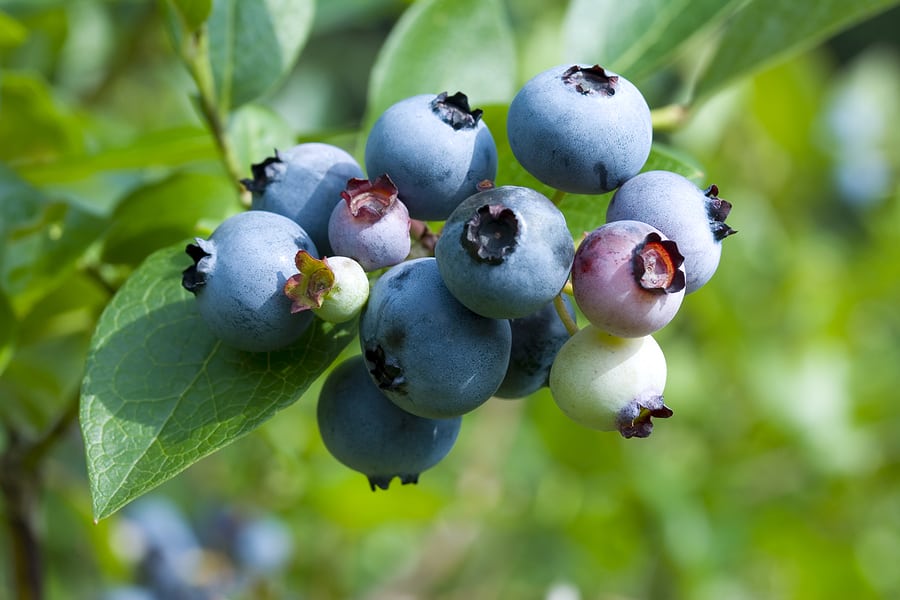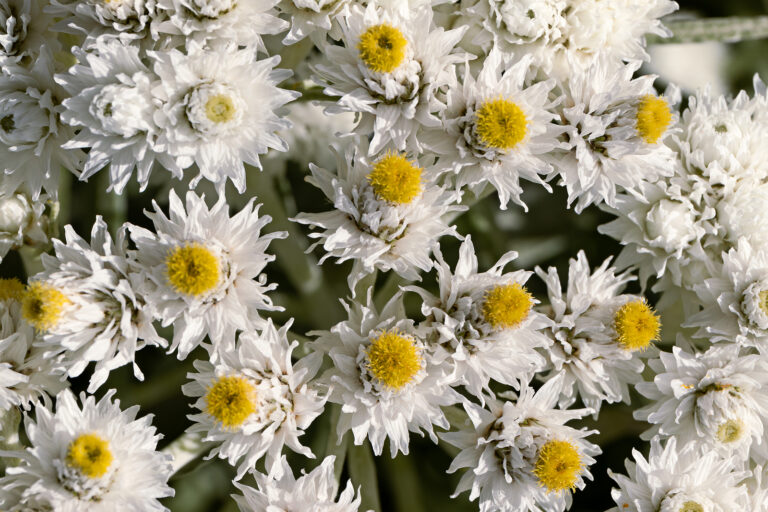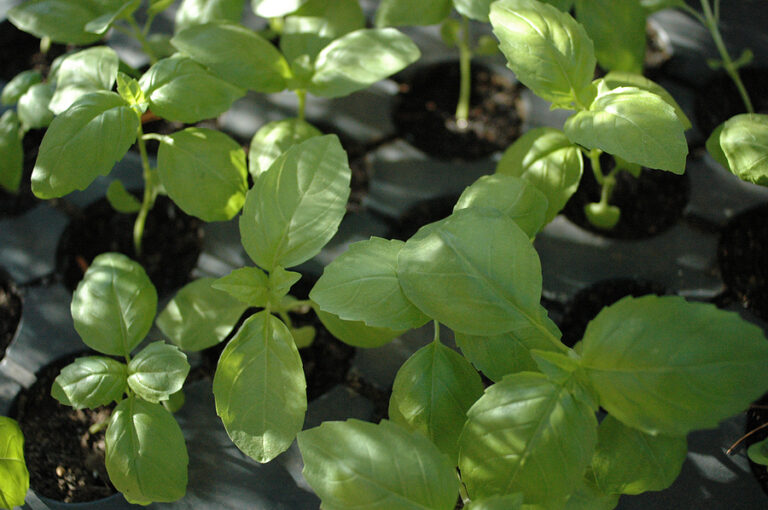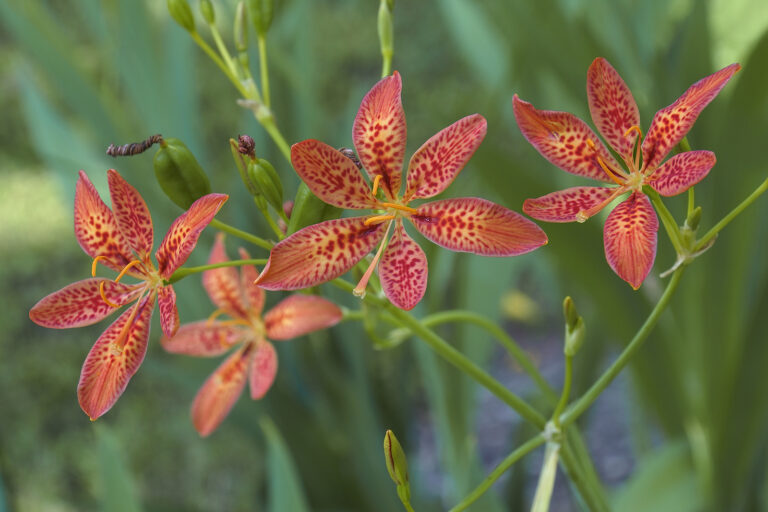Growing Blueberries: A Home Gardener’s Guide
The blueberry is easy to plant and grow. The blueberry plant is best planted and grown where summers are cool and the soil is acidic. There are varieties that will grow in warm, dry summer regions.
Blueberries are long-lived. Plant them where they can grow undisturbed for 10 or more years.
Blueberries flower in the spring; flowers are white or pink and urn-shaped. In summer berries turn from green to pink or red and finally blue. In fall, leaves turn crimson. In winter, young twigs and branches seem to glow red.
Blueberries are native to North America. However, variations of the blueberry—the bilberry, is the chief example—grow in Europe and Asia. In all, there are nearly 150 varieties of blueberry and bilberry although not all of them are edible.
Related articles:
Here is your complete guide to growing blueberry plants.
Best climate and site for growing blueberries
- Blueberries grow best in full sun; they will tolerate shade, but the yield may suffer.
- Blueberries require acidic soil and soil rich in organic matter. The soil must be well-drained.
- Test the soil pH. Blueberries grow best in a soil pH of 4.0 to 5.0. Add sulfur to lower the pH.
- Add a bucket of aged compost to each planting hole.
- Where the soil is alkaline add equal parts sand and aged compost to a hole 2 feet deep and wide before planting.
- Blueberries will not grow well in heavy clay soil.

Choosing the right Blueberry plant
- Blueberries can be purchased as bare-root or container-grown plants.
- Choose certified disease-free plants that are 2 or 3 years old in containers. These will establish themselves more quickly than bare-root plants.
There are three species of blueberries and hybrids to choose from:
Highbush blueberries
- Highbush blueberries (Vaccinium corymbosum) grow best in Zone 4 to 7. Highbush is a shrubby plant that grows to 6 to 12 feet tall; it is native to eastern states along the coast. These plants produce large berries.
Rabbiteye blueberries
- Rabbiteye blueberries ( ashei) is native to the Southeast and can grow as far north as Zone 7. It is heat- and drought-tolerant and can grow to 10 to 20 feet tall. These plants produce pink berries that turn blue when ripe.
Lowbush blueberries
- Lowbush blueberries ( angustifolium) is cold hardy and grow in Zones 3 to 7. Lowbush varieties grow 12 to 18 inches tall. These plants creep near the ground. They produce sweet, small berries.
Mid-high blueberries
- Mid-high hybrid blueberries are hybrid plants with the best qualities of highbush and lowbush plants. Mid-high blueberries grow 18 inches to 3 feet tall. Mid-high plants combine the hardiness and flavor of lowbush varieties with the bigger berries of highbush blueberries.
Types of blueberries and where they grow
Grow early, mid, and late-maturing varieties so that you have a harvest that last 2 months or more. (You may not be able to grow early, mid, and late-maturing varieties in all regions.)
Lowbush blueberries for very cold winters in far northern regions. Lowbush blueberries grow low to the ground, 6 to 18 inches tall. Lowbush varieties are suited for very cold winter regions; draw a line from Nova Scotia to Vancouver, lowbush varieties grow to the north of this line. Lowbush blueberries have a sweet, musky flavor and come to harvest mid-summer.
Half-high blueberries for cold winter plains states. Half-high blueberry varieties are cold-hardy like low-bush blueberries but produce larger fruit, the size of high-bush varieties fruits. These plants are suited for the cold winters of mid-continent states.
Half-high varieties grow 18 to 36 inches tall and bear most of their berries close to the ground. Fruit can be as large as a nickel.
Highbush blueberries for moderately cold-winter regions. Highbush blueberries grow best in northern regions with temperatures moderated by the ocean or Great Lakes—coastal Maine to New York state, southern Ontario and low Michigan, and Northern California to Vancouver.
Highbush blueberries are shrubby growing 4 to 8 feet tall and maturing in about 8 years. They will begin producing in their second year yielding 10 to 20 pounds of fruit per plant. They produce large, sweet berries.
Southern highbush blueberries for mild-winter regions. Southern highbush blueberries are low-chill varieties that can be grown in coastal California and inland valleys, the Sunbelt, and the Southeast region. These varieties are hybridized for soil adaptability, heat tolerance, and low winter chilling. Southern highbush varieties grow from 4 to 6 feet tall and there are varieties that mature early, mid, and late season.
Rabbiteye blueberries for the southern states. Rabbiteye blueberries are native to the southeastern United States growing from Virginia and Tennessee south to Florida and west to Arkansas and Texas in areas that have acid soils. Rabbiteye varieties require less chill than other blueberries. They grow to 10 feet tall and produce large, sweet berries.
Blueberry yield and how much to plant
- Check the berry size of the blueberry variety or cultivar you choose. Large berries are best for fresh eating. Small berries are good for cooking—pancakes and muffins.
- Each blueberry bush will yield 5 to 20 pounds of fruit each year depending on the size of the bush.
- Plants reach full production in 6 to 10 years.
Blueberry pollination
- Some blueberries require cross-pollination; others are self-fertile (self-fertile varieties are not always reliable). Make sure to check which you are planting. If a variety requires cross-pollination, plant two or more plants.
- Plant more than one cultivar to ensure a good fruit set. Planting three different varieties is likely to ensure pollination. Planting more than one cultivar will also extend the harvest.
- Not all blueberry varieties flower at the same time; some flower in early spring, some flower in late spring. To ensure pollination choose varieties that flower at about the same time.
Spacing blueberries
- Highbush blueberries should be planted 6 feet apart.
- Rabbiteye blueberries should be spaced 8 feet apart.
- Lowbush blueberries should be planted 2 feet apart.
- Mid-high, also called half-high, blueberries should be planted 2 to 3 feet apart.
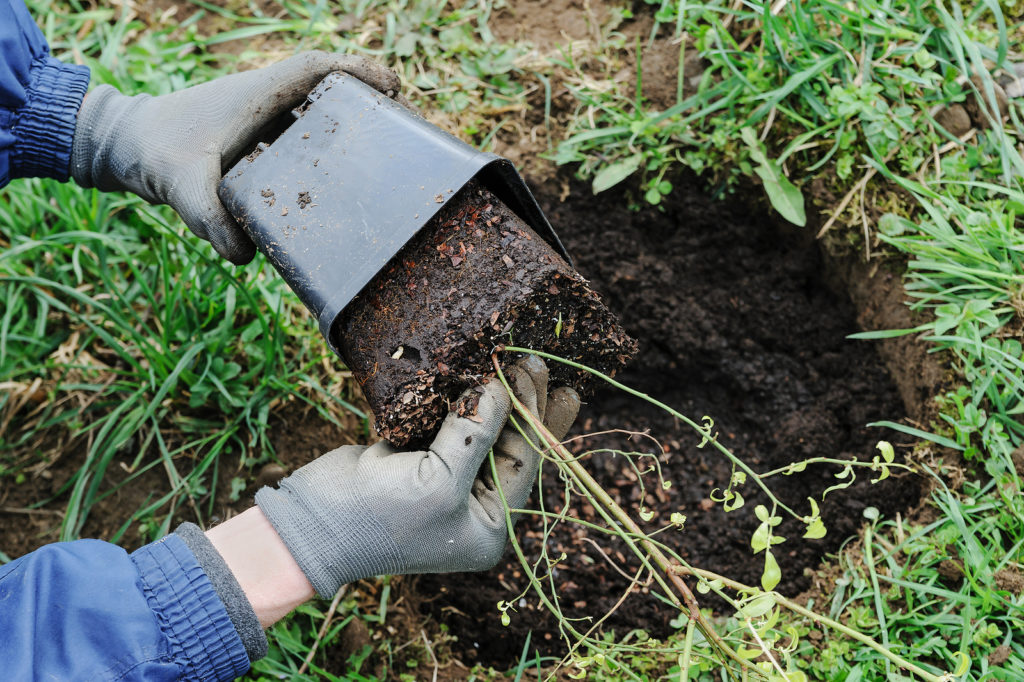
How to plant a blueberry
- Plant bare-root or container-grown blueberries in fall or spring. Do not plant if the ground is frozen or waterlogged.
- Plant blueberries in a sheltered location, out of strong winds.
- If the soil is neutral or naturally alkaline; consider planting blueberries in a raised bed rich in acidic soil.
- Water young plants thoroughly before you transplant.
- Prepare a hole half again as deep as the root ball of the transplant and twice as wide. Moisten the hole.
- Add a cup of bone meal or slow-release organic fertilizer to the bottom of the hole. Cover fertilizer with a thin layer of soil.
- Massage the root ball to separate roots before setting the plant in the hole.
- Set the plant in the hole so that the soil around the crown of the transplant is level with the surrounding soil.
- Firm in the soil around the transplanted root ball ensuring there are no air pockets among the roots. Make sure the crown of the plant is not lower than the surrounding soil.
- Create a basin around the newly planted plant to hold water during irrigation. The basin should be about a foot away from the stem of the plant in all directions.
- Water the newly planted plant with compost tea or a weak solution of fish emulsion.
- After planting apply 3 to 5 inches of aged compost or organic mulch—composted sawdust, leafmold, or pine bark–around each plant. This will keep the soil evenly moist and protect shallow roots from temperature changes.
Container growing blueberries
- Mid-high blueberries are a good choice for growing in containers. Plant them in a 5-gallon pot or a pot 12 to 14 inches in diameter.
- Use an acid potting mix with at least 50 percent aged compost or another acidifying soil amendment.
- Container-grown blueberries can be potted up at any time during the growing season; spring is the best time. Avoid repotting in hot, dry weather.
- Feed container-grown blueberries with an acidic fertilizer or seed meal fertilizer; do not overfertilize. Use a lime-free general fertilizer in spring.
- Mulch the surface of potted blueberries with acidic, organic materials such as aged compost or commercial organic planting mix.
- Never let potted blueberries dry out and do not let the container sit in water.
- In hot summer regions, place containers growing blueberries in partial shade.
- Repot plants every few years during the dormant season.
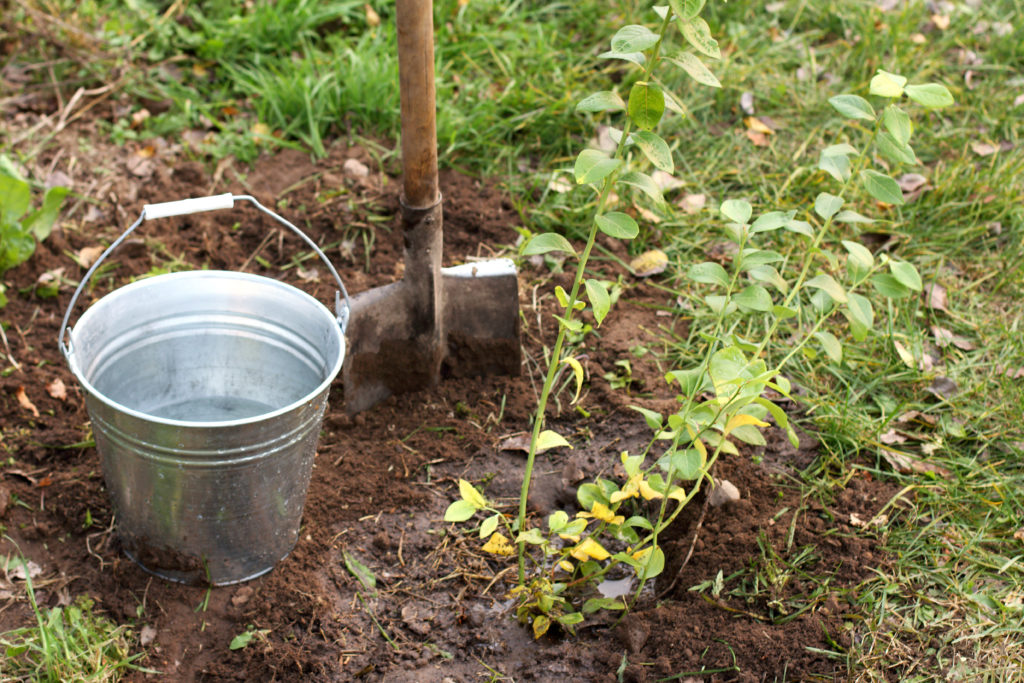
Blueberry care, nutrients, and water
- Blueberries demand constant moisture and excellent drainage.
- Blueberry roots are shallow and should not be disturbed.
- Apply a thick mulch to the base of plants; this will keep down weeds, retain soil moisture, and keep the soil cool.
- Add organic mulch around blueberries at least once or twice a year. As the mulch breaks down the blueberry roots will grow into it.
- Feed plants no more than ¼ pound of nitrogen per year. Top dress plants with bloodmeal in spring.
- Avoid fertilizers that contain lime or calcium. (Do not use tomato or general vegetable fertilizers.)
- Keep the soil evenly moist; consistent even moisture will ensure the largest berries.
- Spreading aged compost or a commercial organic planting mix around blueberries once or twice a year should provide the nutrients blueberries require.
- Early flowering varieties may need to be protected from frost with a floating row cover; cover budded or flowering plants if frost is predicted.
Pruning and training a blueberry
- Blueberries do not lend themselves to formal training. Highbush and rabbiteye blueberries are pruned as informal, upright bushes. Lowbush varieties are low, spreading plants that need only old-growth removed.
- Pinch off flowers and young berries the first year; this will allow the plant to establish its roots and grow strong.
- Remove dead and damaged wood each year as necessary.
- Prune blueberries in winter or spring; remove old wood, damaged branches, and spindly branches. This will allow sunlight to reach the interior of the bush and will encourage new growth.
- If shoots are too crowded, remove some older shoots entirely.
- To increase fruit size, head back shoots that have an abundance of flower buds.
- Allow two new shoots to emerge and grow from the base of the plant each year if you live in northern cold winter regions; allow three or four new shoots to grow in warm-winter southern regions.
- Lowbush blueberry stems can be put to the ground in spring; however, pruned plants will not bear fruit the season following pruning.
Blueberry propagation
- Blueberries are commonly propagated with hardwood or softwood cutting.
- Lowbush blueberries can be divided when dormant.
- Take softwood cuttings in midsummer; select a healthy shoot that is 4 inches long; cut it above a leaf joint and insert the cutting in an acidic potting mix; keep the potting mix just moist.
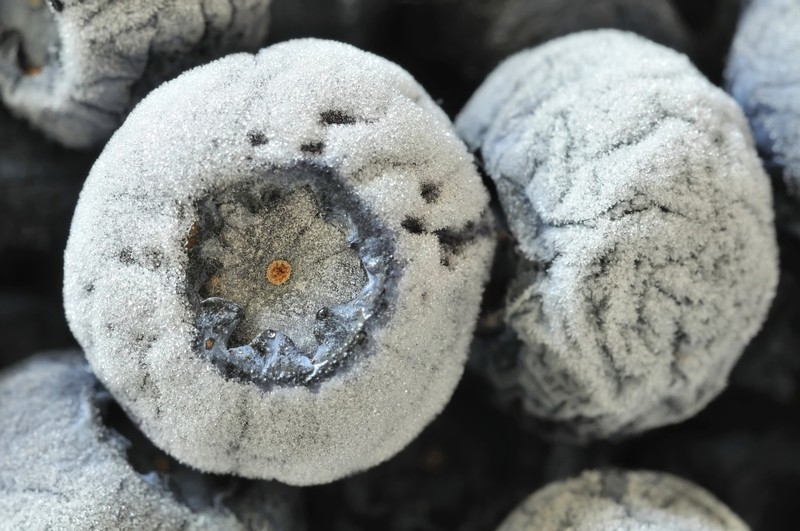
Harvesting and storing blueberries
When picking blueberries, choose berries that are firm, full-colored deep purple-blue to blue-black with slight silver frosting. Blueberries that are green or reddish in color are not ripe. Avoid overripe blueberries as well: they will be soft or watery, or the bottom of their baskets will be stained with juice.
- Blueberry bushes will begin to produce fruit between the second and fourth year after planting.
- Blueberries ripen over a period of 6 to 7 weeks. Not all berries in a cluster ripen at the same time.
- Harvest berries that have turned blue and taste sweet. Leave unripe berries for later harvest.
- Ripe berries will fall readily from the plant when gently tickled.
- Underripe berries will not ripen off the plant; leave them to ripen on the plant.
- Ripe berries will hold on to the bush for about a week; after that, they will deteriorate and drop.
- Berries are very tender and should be handled with care.
- Ripe blueberries are best eaten right away. They will keep in the refrigerator for 1 to 2 weeks.
- Preserve blueberries by freezing, canning, or making jams or jellies.
Also of interest: How to Freeze Blueberries and Other Berries
Try these easy recipes: Fluffy Blueberry Pancakes and Blueberry Crumble
Blueberry problems and controls
- Birds can be kept away from blueberries by placing netting over plants bearing fruit. Nets will also frustrate small squirrels and rodents.
- Blueberry maggots will tunnel into ripening berries. Set stick red ball apple maggot traps in each bush before the berries start to turn blue.
- Stems with cracks or cankers should be cut back to healthy tissue. Plant crack-resistant varieties.
- Mummy berry disease will cause berries to turn white, shrivel, and drop. You can prevent this fungal disease by keeping the mulch around the plants fluffed and airy.
Fall and winter blueberry care
- Remove loose mulch in winter.
- Clean up berries on the ground. Rotten or mummified berries on the ground can harbor pests and diseases.
- Add a fresh layer of mulch before winter cold sets in.
- Prune plants in winter or early spring just before growth begins.
- Prune highbush blueberries by removing wood that is more than four years old, stems that are drooping to the ground, or stems that crowd the center of the plant.
- Prune rabbiteye cultivars similar to highbush varieties, but less severe.
- Prune lowbush varieties by cutting stems to the ground; bushes cut to the ground will not bear fruit in the same season. Alternate pruning lowbush varieties so that some plants are producing fruit each year.
- Repel rabbits that will chew on stems in winter; sprinkle bonemeal or blood meal on the plants. Reapply repellant after rain.
- Apply dormant oil in winter if aphids or scale have been a problem in the past.
Blueberry varieties to grow
- Highbush varieties: Highbush blueberries are the most common blueberries. These are the large, plump, and sweet berries with which you are most familiar. Highbush blueberries grow from 0.9 to 1.8 meters (3 to 6 feet) tall and are grown where there is acid soil and where they can benefit from a chilly winter that brings on dormancy which, in turn, enhances growth and bloom in the spring. Highbush blueberry country includes Michigan, New Jersey, North Carolina, Oregon, Washington, and British Columbia. Highbush varieties to grow include ‘Berkeley’ (mid to late season); ‘Bluecrop’ (mid-season); ‘Blueray’ (mid); ‘Bluetta’ (early); ‘Darrow’ (late); ‘Duke’ (early); ‘Elizabeth’ (mid to late); ‘Elliott’ (late); ‘Herbert’ (mid to late); ‘Jersey’ (mid to late); ‘Patriot’ (early to mid); ‘Spartan’ (early).
- Half-high varieties: ‘Chippewa’ (mid-season); ‘Friendship’ (mid); ‘Northblue’ (mid); ‘Northsky’ (mid); ‘Polaris’ (mid); ‘St. Cloud’ (mid).
- Lowbush varieties: Lowbush blueberry varieties stand 15-46 centimeters (6-18 inches) tall and produce small berries with intense flavor. These blueberries grow wild from Minnesota to Maine and in the Maritime Provinces of Canada—Newfoundland, Prince Edward Island, New Brunswick, and Nova Scotia. Not surprisingly, you will find these sold at the market as “wild blueberries.” A variety to grow is ‘Chignecto’ (mid-season).
- Southern highbush varieties: ‘Sharpblue’ (early); ‘Misty’ (early).
- Rabbiteye varieties: ‘Brightwell’ (early to mid); ‘Powder Blue’ (late); ‘Tifblue’ (mid to late).
Garden Planning Books at Amazon:
- Vegetable Garden Almanac & Planner
- Kitchen Garden Grower’s Guide Vegetable Encyclopedia
- Vegetable Garden Grower’s Guide
- Tomato Grower’s Answer Book
More fruit-growing articles:
Learn how to plant, grow, prune, and harvest your favorite fruits. Click below for all you need to know.
- Apple
- Apricot
- Avocado
- Banana
- Blackberry
- Blueberry
- Cantaloupe
- Chayote
- Cherimoya
- Cherry
- Citrus
- Clementine
- Cranberry
- Currants
- Elderberry
- Feijoa
- Fig
- Gooseberry
- Grape
- Grapefruit
- Guava
- Kiwifruit
- Kumquat
- Lemon
- Lime
- Loquat
- Mandarin
- Mango
- Melon
- Mulberry
- Muskmelon
- Nectarine
- Olive
- Orange
- Papaya
- Passion Fruit
- Peach
- Pear
- Persimmon
- Pineapple
- Pineapple Guava
- Plantain
- Plum
- Pomegranate
- Pumpkin
- Quince
- Raspberry
- Strawberry
- Tangelo
- Tangerine
- Tangor
- Watermelon

